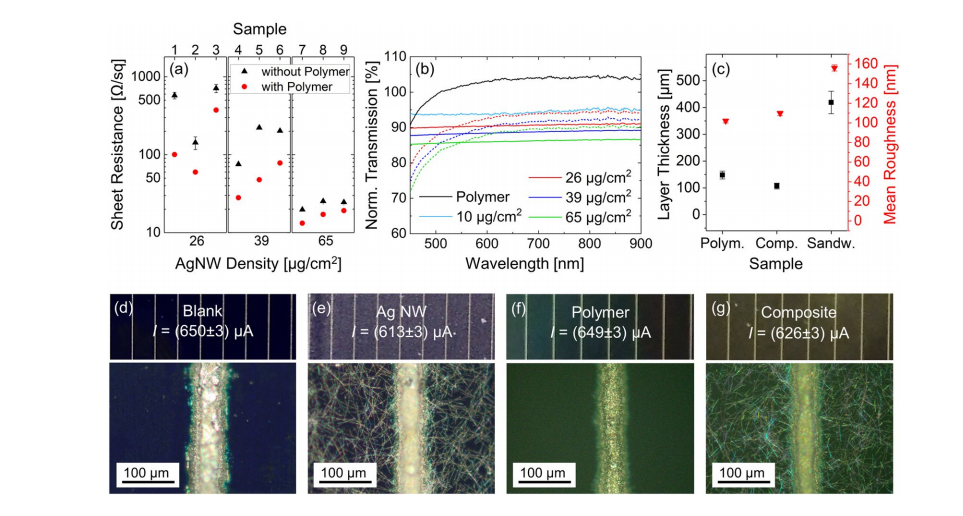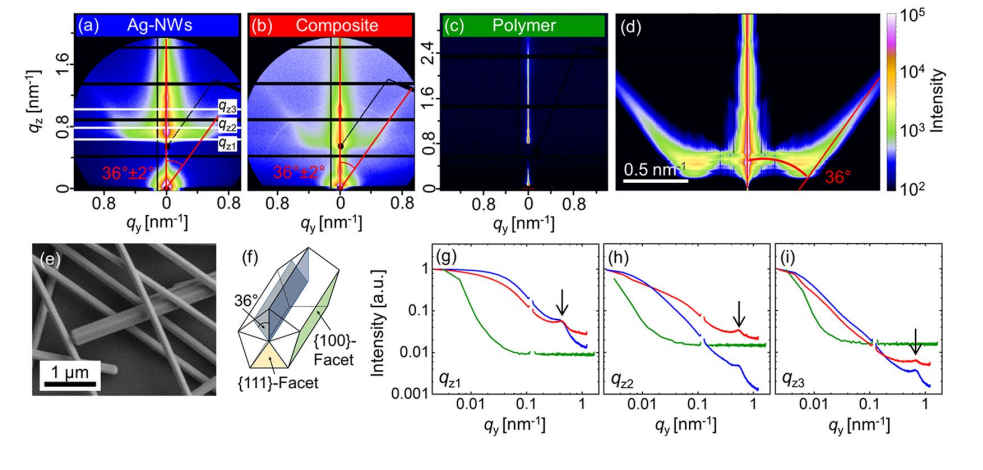Conductive Silver-Nanowire Photopolymer Composites: 3D Printing for Greater Functionality
A large group of researchers convened to explore more about additives and new combinations of materials in 3D printing, outlining their findings in the recently published ‘Functional Printing of Conductive Silver-Nanowire Photopolymer Composites.’
Explaining that the use of polymers in 3D printing—and the inherent challenges found therein—has caused significant limitations, the researchers experimented with silver-nanowire-polymer composites, noting that conductive layers can be critical to specific manufacturing needs such as electronics applications; however, composites must be strong against tunneling resistance (as electrons transfer from one nanoparticle to another), and previous researchers have struggled to create materials with suitable conductivity due to issues like agglomeration and strong photon absorption. With nanowires, another route is available as it ‘circumvents the tunneling resistance in the direction of the wire.’
Silver-nanowire (Ag-NW) composites offer ‘scalable processes’ requiring conductivity, to include:
- Electronics
- Touch screens
- Integrated photovoltaics
- Advanced optoelectronic devices
- Biosensors
Samples were coated with an Ag-NW layer, cured with UV light, and then synthesized via the polyol route. The result was nanowires exhibiting high aspect ratios—in this case, from 100-1000. Resins tend to compress while curing, with shrinking of the matrix pressing on nanowires during the process of polymerization. Lack of density also results in greater sensitivity for nanowire connections and networks.

Characterization and 2D printing of the tough Ag-NW-polymer composite. (a) Impact of the polymer crosslinking on the Ag-NW composite conductivity by comparing the sheet resistances of Ag-NW networks (black dots) and Ag-NW composites (red dots) for 3 different Ag-NW densities (26 µg/cm2, 39 µg/cm2 and 65 µg/cm2). At high Ag-NW densities, the reproducibility of the measured sheet resistance is enhanced, but the impact of the polymer coating on the conductivity is reduced. (b) Transmission of visible to near-infrared light through Ag-NWs and Ag-NW composites. Solid lines indicate pure polymer or Ag-NW films, whereas dashed lines indicate Ag-NW composites. The transmission is larger than 87% for all composites between 600nm and 800nm normalized to a bare glass substrate. The polymer coating decreases scattering and refection at the glass interface resulting in an enhanced transmission compared to a bare glass slide. (c) Exemplary layer thickness and roughness of the produced polymer samples: pure polymer layer, Ag-NW (7 µg/cm2) composite and polymer-Ag-NW (22 µg/cm2 )-polymer multilayer sample. Please note that layer thicknesses between 20–300 µm represent typical thicknesses in functional printing. Te thickness to surface roughness ratio is >1000:1. (d) Photograph and optical microscopy image of a blank solar cell (monocrystalline, 60010, Sol-Expert). A photocurrent I of 650 µA was measured during exposure with an Ulbricht sphere. (e–g) Photographs, optical microscopy images and measured photocurrents of coated solar cells ((e) Ag-NWs, (f) polymer, (g) composite).
During increased nanowire concentration, there was decreased transmittance, and optimized conductivity at fairly low nanowire concentrations, demonstrating a ‘delicate interplay’ between the polymer matrix and Ag-NW network. The researchers also found it remarkable that surface roughness was at 110–160nm for the Ag-NW composites—attributed to polymer roughness.
“These results show that the composite Ag-NW-polymer materials can act as competitive materials for conducting and light-transparent electrodes,” stated the researchers.

Two-dimensional (2D) GISAXS pattern from the samples. (a) Ag-NWs (58 µg/cm2). (b) Ag-NWs (7µg/cm2) coated with UV-cured polymer layer. (c) Bare UV-cured polymer. The intensity scale bar is shown on the right side. Clear fares at 36°±2° (indicated by red lines) stemming from the facets of the pentagon morphology starting from the sample horizon are visible for (a,b). (d) Simulation of the key scattering features of Ag-NWs. (e) SEM image of Ag-NWs on a silicon substrate (Ag-NW density around 120 µg/cm2). (f) Sketch of the faceted Ag-NW (adapted from44,45). (g) Horizontal cuts of the intensity (I(qy,qz1=0.63nm−1)), (h) I(qy,qz2=0.78nm−1), (i) I(qy,qz3=0.96nm−1). All cuts are normalized to the intensity at I(0,qz1,2,3) correspondingly. The color code corresponds to (a–c).
During the initial stages of synthesis, five-fold twinned seeds formed, with pentagonal structure and twinned tops of Ag-NWs also confirmed during SEM evaluations (although not applicable for the material). Pentagonal morphology was established as the researchers simulated key features of the GISAXS pattern, via specialized software.
For 3D printing, the research team fabricated a capacitator made up of Ag-NWs and Flexible photopolymers by Formlabs. They were not only able to show the potential for 3D printed electronics, but also the role that composites play in improving functionality.

Flexible Ag-NW composite capacitor. (a) Illustration of the cross-section of the capacitor. (b) Photograph of a produced Ag-NW capacitor (10×10 mm2
). The dashed white line depicts the position of the cross-section, which is presented in (a). (c) Photograph of the capacitor bent over a glass rod in order to
demonstrate its flexibility. (d) Cross-sectional view of the lower part of the stripped of the capacitor with Ag-NWs.
“By applying two different polymers, we have fabricated composites with different properties that were tested for two specific applications. Firstly, we have optimized Ag-NW composites for use as transparent top contacts by tuning the Ag-NW concentration within a tough and transparent HDDA-based polymer matrix. We have accomplished a sheet resistance of 13Ω/sq and a corresponding transmission at 700nm of 90%,” concluded the researchers. “Secondly, we have used a flexible polymer matrix in the composite for a 3D-printed flexible capacitor.
“The capacity of around 7pF agrees well with the estimated value of about 5 pF. Our characterization involves GISAXS, which enables the investigation of embedded nanostructures and interfaces with high statistical relevance. Tis shows that GISAXS can develop further to an excellent technique for the investigation of embedded nanostructures in 3D-printed and technically relevant films.”
The science of materials continues to grow, and within that, composites are becoming a large part of refining functionality for many different applications. Researchers are working with a wide range of different additives, from glass fibers to lignin and other wood composites, while many different materials show potential, like antioxidants. What do you think of this news? Let us know your thoughts! Join the discussion of this and other 3D printing topics at 3DPrintBoard.com.
[Source / Images: ‘Functional Printing of Conductive Silver-Nanowire Photopolymer Composites’]Subscribe to Our Email Newsletter
Stay up-to-date on all the latest news from the 3D printing industry and receive information and offers from third party vendors.
Print Services
You May Also Like
3D Printing Grows to $15.9B in 2024 Amid Shifting Industry Dynamics
The global additive manufacturing (AM) market reached $15.9 billion in calendar year 2024, according to “Q4 2024 3DP/AM Market Data and Forecast” from Additive Manufacturing Research (AM Research). Despite a...
Low-cost “Suzy” Polymer Powder 3D Printer is Faster and Cheaper than Past Models
Polish laser powder bed fusion (LPBF) firm Sinterit has released a follow-up to its predecessors, Lisa and Nils, called Suzy, a $19,490 printer equipped with a 30W fiber diode laser....
BellaSeno’s 3D Printed Breast Implants Keep Shape with 87% Fat Volume, Avoids Silicone Risks
At a medical conference in Austin this week, a new kind of breast implant took center stage. It is not made from silicone but from a 3D printed, fully resorbable...
Australia’s Untapped Potential as a Disruptive Innovator: SPEE3D CTO Steven Camilleri Explains Why He Wants to Make Stuff There
When I first met Steven Camilleri in 2023, the CTO of additive manufacturing (AM) OEM SPEE3D shared a quote with me from Clayton Christensen, the late Harvard professor who popularized...


























